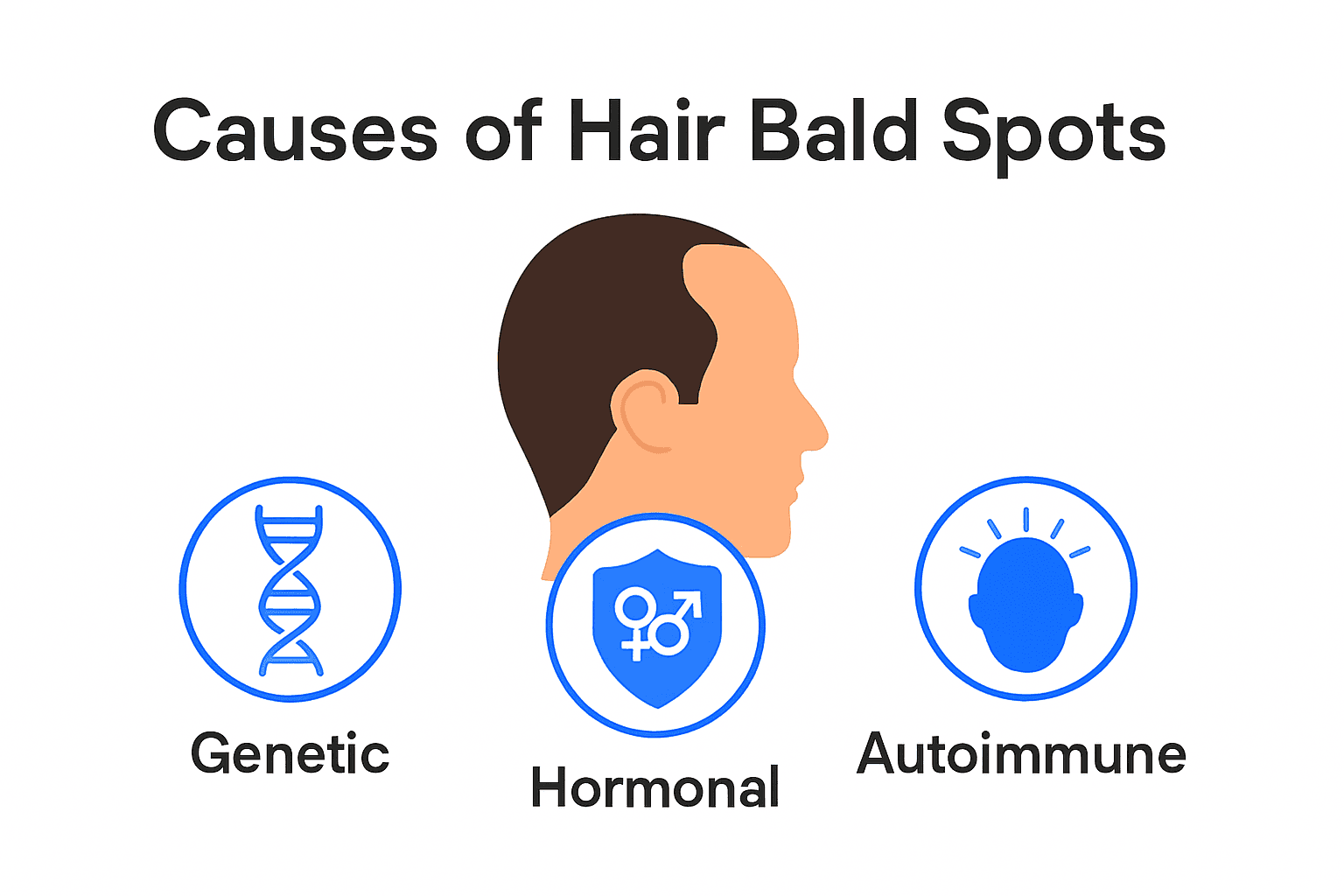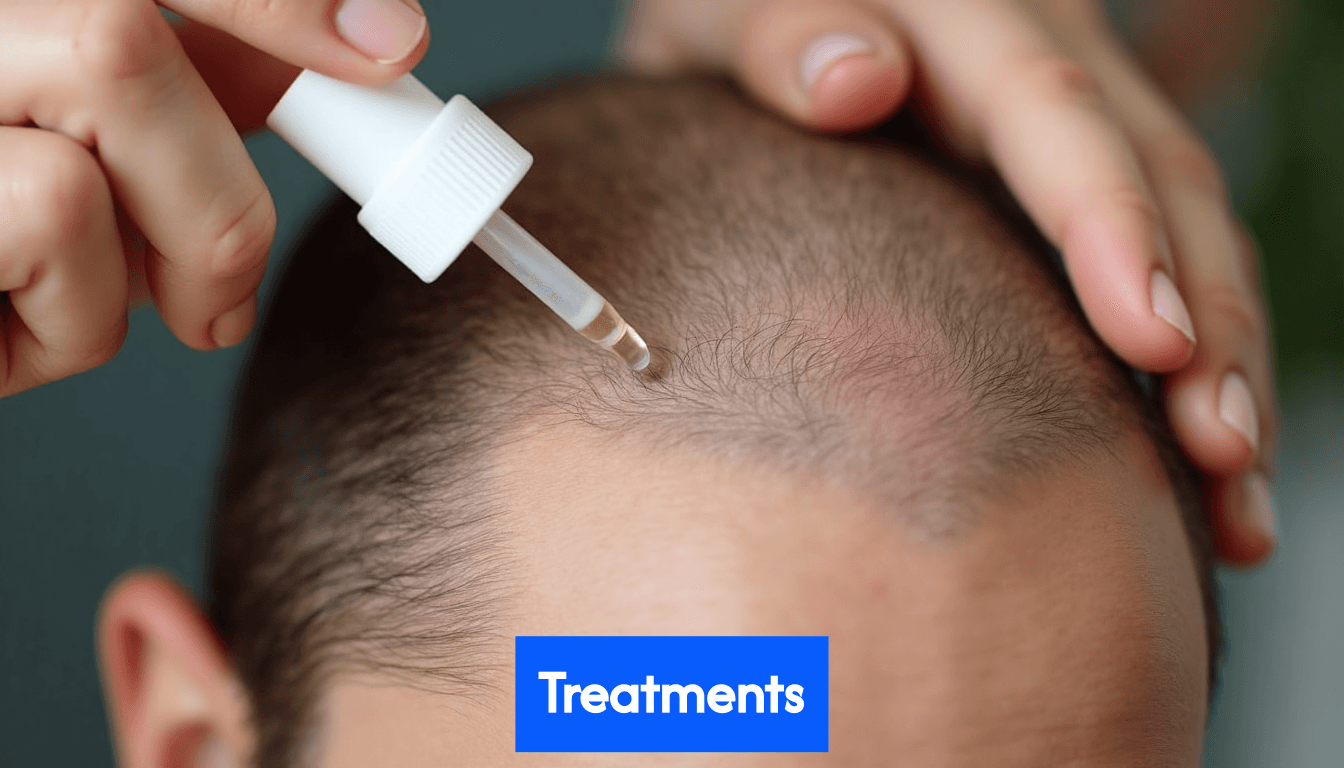Blog
Learning Materials
Hair Bald Spot Treatment: Effective Solutions for 2025
Updated: June 25, 2025

Hair bald spots can feel like the ultimate confidence killer. Here’s the curveball. New research shows that a groundbreaking molecule called PP405 delivered a hair density increase of over 20 percent for 31 percent of people in recent clinical trials. But the biggest surprise is not the molecule itself, it’s how the smartest success stories are blending cutting-edge science with natural fixes and even AI-driven personalization. What really works in 2025 might be the treatment path you least expect.
Table of Contents
- Understanding Hair Bald Spots And Causes
- Proven Medical And Natural Treatments
- Tracking Progress And Hair Regrowth
- Personalized Options And Expert Tips
Quick Summary
| Takeaway | Explanation |
|---|---|
| Understanding Bald Spots | Bald spots result from complex biological processes, including genetic factors, stress, and hormonal changes, which disrupt the hair growth cycle. |
| Combination Treatment Approaches | Effective bald spot treatment combines medical interventions, such as finasteride and stem cell therapy, with natural remedies like essential oils and nutritional supplements. |
| Importance of Tracking Progress | Systematic tracking of hair regrowth through photographic documentation and detailed treatment diaries helps individuals monitor effectiveness and maintain motivation during the restoration process. |
| Personalized Treatment Strategies | Advances in AI-driven technologies allow for highly customized treatment plans based on individual scalp conditions, genetic markers, and lifestyle factors, offering tailored solutions for hair loss management. |
| Holistic Wellness Integration | Addressing hair loss effectively includes managing stress, optimizing nutrition, and conducting comprehensive evaluations by healthcare professionals to ensure a multi-faceted approach to restoration. |
Understanding Hair Bald Spots and Causes
Bald spots represent a complex hair loss phenomenon that goes far beyond simple aesthetic concerns. Understanding the underlying mechanisms helps individuals take proactive steps in managing and potentially reversing hair loss.
The Science Behind Hair Loss Mechanisms
Hair loss is not a random occurrence but a result of intricate biological processes. Research from the National Institutes of Health reveals that autoimmune conditions like alopecia areata fundamentally disrupt the normal hair growth cycle. In this condition, the body's immune system mistakenly attacks hair follicles, causing sudden and often unpredictable hair loss.
Genetic factors play a significant role in bald spot development. According to genetic studies, approximately 80% of men experiencing hair loss have a genetic predisposition inherited from their fathers. This hereditary pattern, known as androgenetic alopecia, involves hormonal interactions where dihydrotestosterone (DHT) shrinks hair follicles, progressively reducing hair thickness and coverage.

Common Triggers for Bald Spot Development
Multiple factors contribute to bald spot formation. Stress emerges as a critical trigger, causing telogen effluvium where hair prematurely enters a resting phase and subsequently falls out. Nutritional deficiencies particularly in iron, protein, and vitamin B12 can accelerate hair follicle deterioration. Hormonal changes during pregnancy, menopause, or thyroid disorders also significantly impact hair growth patterns.
Medical conditions like scalp infections, autoimmune disorders, and certain medications can accelerate bald spot progression. Chemotherapy, thyroid imbalances, and conditions such as lupus directly interfere with normal hair follicle functioning. Individuals experiencing persistent hair loss should consult healthcare professionals to rule out underlying medical issues.
Advanced Understanding of Hair Follicle Dynamics
Modern research indicates that hair follicle health depends on complex cellular interactions. Stem cells located in the hair follicle bulge region are crucial for regenerating hair. When these stem cells become damaged or dysfunctional, hair regrowth becomes challenging. Environmental factors like pollution, excessive heat styling, and chemical treatments can accelerate this cellular damage.
Interestingly, our guide on crown hair loss solutions provides deeper insights into specific bald spot patterns and targeted treatment strategies. Understanding individual hair loss mechanisms empowers individuals to seek personalized interventions that address their unique biological profile.
Advanced diagnostic technologies now allow precise tracking of hair follicle health. AI-driven platforms can analyze scalp conditions, predict potential hair loss trajectories, and recommend targeted interventions before significant hair thinning occurs. This proactive approach transforms hair loss management from reactive treatment to predictive care.
Recognizing bald spots as a complex interplay of genetic, environmental, and physiological factors is the first step toward effective management. By understanding these intricate mechanisms, individuals can make informed decisions about their hair health and explore personalized treatment options.
Proven Medical and Natural Treatments
Addressing hair bald spots requires a comprehensive approach that combines medical interventions and natural strategies. The evolving landscape of hair restoration offers multiple promising pathways for individuals seeking to combat hair loss.
Advanced Medical Interventions
Pharmaceutical Treatments represent the first line of medical approach for hair bald spot treatment. Medications like minoxidil and finasteride have long been standard treatments. Research from the University of Virginia suggests emerging molecular therapies are revolutionizing hair restoration strategies.
A groundbreaking development is the PP405 molecule, which has demonstrated significant potential in hair regrowth. Clinical trials reported in Dermatology Times revealed that 31% of participants experienced over 20% increase in hair density. This represents a substantial advancement in targeted hair regeneration techniques.
Stem cell therapy emerges as another cutting-edge medical intervention. Advanced research from regenerative medicine experts indicates this approach can effectively target inflammation and stimulate follicular regeneration. The procedure involves extracting and reimplanting a patient's own stem cells, potentially reversing hair loss at its cellular origin.
Natural and Holistic Approaches
Natural treatments offer complementary strategies for managing bald spots. Nutritional interventions play a crucial role in hair health. Key nutrients like biotin, zinc, and vitamin D directly influence hair follicle strength and growth potential. Dietary modifications can support internal hair restoration mechanisms.
Topical natural treatments have gained significant traction. Essential oils such as rosemary, peppermint, and lavender demonstrate promising results in stimulating hair growth. Scientific studies suggest these oils can improve blood circulation in the scalp and potentially activate dormant hair follicles.
Herbal supplements like saw palmetto and ginseng have shown potential in blocking DHT production, a primary contributor to male pattern baldness. These natural compounds offer a gentler alternative to pharmaceutical interventions, with fewer reported side effects.
Integrative Treatment Strategies
The most effective approach to bald spot treatment combines medical and natural strategies. Personalized treatment plans that consider individual genetic predispositions, lifestyle factors, and overall health yield the most promising outcomes.
Our comprehensive guide on crown hair loss solutions provides deeper insights into tailoring treatment approaches. AI-driven diagnostic technologies now enable precise tracking of hair loss progression, allowing for more targeted and personalized interventions.

Embracing a holistic approach means considering multiple factors. Stress management, proper nutrition, scalp care, and targeted medical treatments can work synergistically to address bald spots. Regular consultation with healthcare professionals and continuous monitoring are essential for developing an effective, long-term hair restoration strategy.
The future of bald spot treatment lies in personalized, technology-driven solutions that address individual biological variations. By combining advanced medical research with natural healing approaches, individuals can develop comprehensive strategies for hair restoration and scalp health.
Tracking Progress and Hair Regrowth
Successful hair bald spot treatment requires more than just applying remedies. Systematic tracking and understanding of hair regrowth processes are crucial for achieving meaningful results and maintaining motivation throughout the restoration journey.
Scientific Measurement Techniques
Objective progress tracking begins with standardized documentation. Dermatology experts recommend precise photographic documentation under consistent lighting conditions every three months. This approach helps patients overcome perceptual biases and accurately assess hair density changes.
Modern technologies have revolutionized hair regrowth monitoring. Digital scalp analysis platforms now offer microscopic tracking of individual hair follicle health. These advanced systems can measure parameters like hair thickness, density, and growth rate with unprecedented precision. AI-driven algorithms compare current scalp conditions against baseline measurements, providing quantitative insights into treatment effectiveness.
Comprehensive Progress Documentation
Maintaining a detailed treatment diary is critical for understanding individual hair restoration trajectories. Research indicates that patients who meticulously record application consistency and potential side effects achieve more predictable outcomes. Key documentation elements include:
- Frequency of treatment application
- Photographic evidence at regular intervals
- Observations of scalp condition
- Lifestyle and dietary changes
Our comprehensive guide on natural hair growth routines provides additional strategies for effective progress tracking. Understanding that hair regrowth is a gradual process helps set realistic expectations and maintains patient motivation.
Interpreting Regrowth Signals
Recognizing subtle signs of hair restoration requires specialized knowledge. Initial regrowth often manifests as fine, soft hair known as vellus hair. These delicate strands represent the first indication of successful follicle reactivation. Patients should not be discouraged by seemingly minimal changes, as these represent critical biological signals of recovery.
Clinical trials provide encouraging perspectives on treatment efficacy. A recent phase 2a study demonstrated that 31% of participants experienced more than a 20% increase in hair density. This statistic underscores the importance of patience and consistent treatment adherence.
Advanced diagnostic technologies now enable predictive modeling of potential hair restoration outcomes. By analyzing genetic markers, scalp conditions, and individual biological responses, these platforms can generate personalized prognosis models. This approach transforms hair regrowth tracking from a reactive to a proactive strategy.
Effective progress tracking is a multifaceted approach combining scientific measurement, consistent documentation, and nuanced interpretation of biological signals. By embracing comprehensive monitoring techniques, individuals can optimize their hair restoration journey, making informed decisions based on objective data rather than subjective perceptions.
The future of hair bald spot treatment lies in personalized, data-driven approaches that empower individuals with precise insights into their unique hair regeneration potential.
Personalized Options and Expert Tips
In the rapidly evolving landscape of hair restoration, personalized approaches have emerged as the most promising strategy for addressing individual bald spot challenges. The future of hair loss treatment is no longer about one-size-fits-all solutions but tailored interventions that consider unique biological profiles.
Advanced Personalization Technologies
AI-driven research from Dermatology Times reveals groundbreaking developments in personalized hair loss treatment. Advanced algorithms now analyze individual scalp conditions, genetic markers, and lifestyle factors to create highly customized treatment regimens. These sophisticated models have demonstrated significant improvements in hair growth, thickness, and scalp coverage over six-month periods.
Personalized treatment strategies now incorporate a comprehensive approach. Expert analysis from Alviar Mani Clinics highlights innovative techniques including targeted DHT blockers, advanced nutraceuticals, and specialized drug therapies like JAK inhibitors. This multi-dimensional approach allows for treatments precisely calibrated to individual hair loss causes and patient profiles.
Comprehensive Treatment Customization
Modern hair restoration embraces a holistic view of treatment. Clinical insights from advanced hair restoration centers suggest combining multiple techniques for optimal results. These may include:
- Follicular Unit Extraction (FUE)
- Platelet-Rich Plasma (PRP) Therapy
- Scalp Micropigmentation
- Personalized Nutritional Interventions
Our comprehensive guide to natural hair growth routines provides additional insights into creating personalized hair restoration strategies. The key lies in understanding that each individual's hair loss journey is unique.
Expert Recommendations for Personalized Care
Top hair restoration specialists emphasize the importance of a comprehensive diagnostic approach. This involves:
- Detailed genetic screening
- Comprehensive hormonal assessments
- Lifestyle and nutritional evaluation
- Advanced scalp microbiome analysis
Experts recommend a patient-centric approach that considers multiple factors beyond traditional treatment methods. Stress management, nutritional optimization, and targeted interventions create a holistic strategy for hair restoration.
Emergent technologies now enable unprecedented levels of personalization. Genetic testing can predict potential hair loss patterns, allowing for preemptive interventions. Advanced diagnostic tools can map individual hair follicle health with microscopic precision, creating treatment plans that are as unique as a fingerprint.
The future of hair bald spot treatment is deeply personal. It's not just about addressing hair loss but understanding the intricate biological narrative of each individual's scalp health. By embracing personalized, data-driven approaches, individuals can now access treatments that are precisely tailored to their specific needs, offering hope and tangible results in the fight against hair loss.
Frequently Asked Questions
What are the main causes of hair bald spots?
Bald spots can result from various factors, including genetic predisposition, stress, hormonal changes, and autoimmune conditions like alopecia areata. Nutritional deficiencies and certain medical conditions also contribute to hair loss.
Are there any effective treatments for hair bald spots in 2025?
Yes, effective treatments for hair bald spots in 2025 include advanced medical interventions like the PP405 molecule and stem cell therapies, combined with natural approaches such as essential oils and nutritional supplements.
How can I track my hair regrowth progress?
Tracking hair regrowth involves regular photographic documentation in consistent lighting, maintaining a detailed treatment diary, and utilizing digital scalp analysis platforms to monitor individual hair follicle health and growth rates.
What is the importance of personalized treatment strategies for hair loss?
Personalized treatment strategies are crucial as they consider individual genetic markers, scalp conditions, and lifestyle factors, enabling tailored solutions that enhance the effectiveness of hair regrowth treatments.
Ready to Take Control of Your Bald Spots with AI Precision?
Struggling with relentless bald patches, slow regrowth, or uncertainty about which treatment actually works? The article above highlighted how new science, personalized strategies, and tech like AI are changing the game in 2025. But the journey can still feel tough — especially when you just want answers that fit you, not everyone else.

Get ahead of the next hair loss breakthrough. Upload your own scans, track real progress, and receive tailored recommendations with MyHair.ai's AI-powered hair health platform. Start your own transformation now and see in-depth, personalized advice that adapts as your journey continues. Take your first step today at MyHair.ai — your data-driven future for scalp confidence begins here.